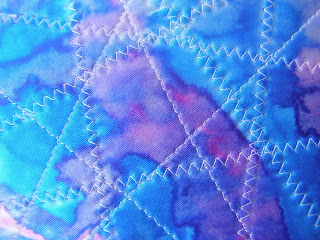For the next experiment, I sponged violet and red transfer paint on to the photocopier paper quite thickly, leaving lighter patches in between. I used an iron on the 'wool' setting to transfer this on to the white satin. This time the colour transfer was slightly more effective, but still not as bright as I would have like. The red came out as orange, which was surprising.
 |
| Purple and red paint sponged onto paper |
 |
| Transferred on to white satin |
I wanted to achieve a much stronger, brighter effect with my next example, so this time I applied violet and red paints again with a medium sized paintbrush in big 'splodges' on to paper. I let quite heavy pools of paint collect and left this to dry. When I transferred this over to the white satin, I tried using heavier pressure with the iron and left it for longer, taking care not to singe the fabric. I was much more pleased with the result this time, as the colours came out much brighter (although the red still looked orange!)
 |
| A much brighter effect was achieved this time on the satin! |
Feeling that I had finally 'got the hang' of this technique, I tried a few more experiments...
I used a large brush and a sponge to colour the next piece of paper with violet and golden yellow transfer paint, again quite heavily.
 |
| Purple and yellow paint applied to paper |
I used the same technique as in the previous sample to transfer the colours over to white satin. These transferred quite well, but the yellow looks green and I realised that in my quest to achive deep colours, I had applied too much violet, so the final effect doesn't really have enough constrast.
I wondered what would happen if I applied green and purple paints together (if yellow looked green, what would green look like?!). I used a large brush again to apply the paint quite heavily to paper, and this time used slightly less purple than before. I also allowed the green time to dry slightly before adding the purple.
The paints transferred very successfully and there is a pleasing balance between the darker and lighter colour this time. Also, the green came out green, although lightly darker than the yellow transfer paint!






























